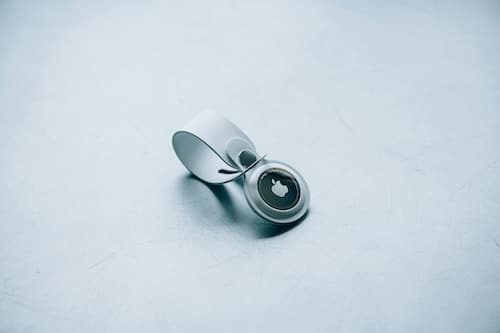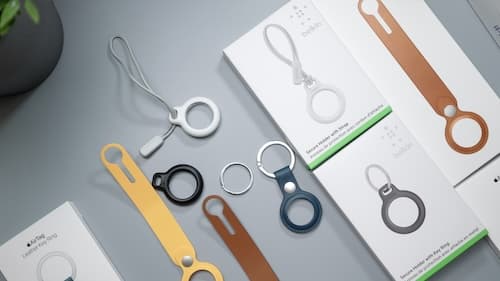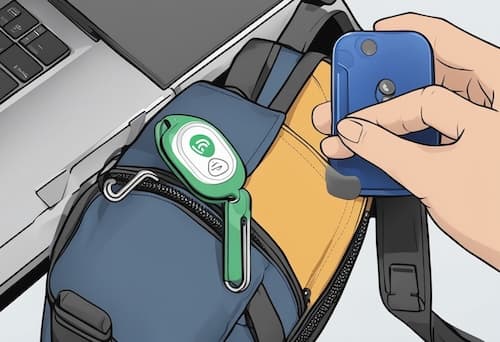Setting up AirTags is a simple process that allows users to track their belongings using Apple’s Find My app. AirTags are small, circular devices that can be attached to keys, wallets, or other items to help locate them if they are lost or misplaced. Once set up, AirTags can be tracked using the Find My app on an iPhone, iPad, or iPod touch.
To set up an AirTag, users need to have an iPhone, iPad, or iPod touch running iOS 14.5 or later. They also need to have an Apple ID and the Find My app installed on their device. To begin the setup process, users need to pull out the plastic tab on the AirTag to activate the battery. They can then hold the AirTag near their iPhone and follow the on-screen instructions to connect it to their device.
Once connected, users can choose a name for their AirTag and link it to their Apple ID. They can also customize the name and add an emoji to make it easier to identify. After completing the setup process, users can start using the Find My app to track their AirTagged items. Overall, setting up AirTags is a quick and easy process that can provide peace of mind for those who frequently misplace their belongings.

Understanding Airtags
AirTags are small, circular, and lightweight devices that can be attached to personal items such as keys, wallets, or backpacks to help locate them if they are lost or misplaced. They work by using Bluetooth technology to communicate with nearby Apple devices, such as iPhones, iPads, or Macs, that have the Find My app installed.
When an AirTag is set up, it is associated with the user’s Apple ID and added to the Find My network, which is a collection of Apple devices that can help locate lost items. If an AirTag is lost and out of range of the user’s devices, it can still be located using the Find My network. When another Apple device comes into range of the lost AirTag, it can anonymously relay its location back to the owner.
To set up an AirTag, the user needs to have an iPhone, iPad, or iPod touch running iOS 14.5 or later. They also need to have an Apple ID and the Find My app installed on their device. Once the AirTag is activated by pulling out the plastic tab, the user can hold it near their device to begin the setup process.
During the setup process, the user is prompted to name the AirTag and assign it to a specific item. This makes it easier to identify which item the AirTag is attached to in the Find My app. The user can also choose to enable Lost Mode, which will notify them if the AirTag is detected in an unfamiliar location and allow them to remotely lock it with a passcode.
Overall, AirTags are a simple and convenient way to help keep track of personal items. They are easy to set up and use, and can provide peace of mind knowing that lost items can be located using the Find My network.
Purchasing Your Airtag
When it comes to purchasing an AirTag, there are a few things to consider. In this section, we’ll cover the basics of choosing the right AirTag for your needs and where you can buy one.
Choosing the Right Airtag
AirTags come in a single design, a small and circular disc-shaped device with a white front and a silver back. However, you can customize your AirTag with a variety of accessories, such as keyrings or loops, to attach it to your belongings.
Before purchasing an AirTag, consider what you’ll be using it for. If you’re looking to track items that are frequently misplaced in your home, a single AirTag may be sufficient. However, if you need to keep track of multiple items, you may want to purchase a pack of AirTags, which provides a discount over buying them individually.
Where to Buy
AirTags are available for purchase from a variety of retailers, both online and in-person. Some of the most popular places to buy AirTags include:
- Apple Store: You can purchase AirTags directly from the Apple Store, either online or in-person. If you purchase an AirTag from the Apple Store, you can also take advantage of Apple’s engraving service to personalize your device.
- Amazon: Amazon also sells AirTags, often at a discount compared to the Apple Store. However, be sure to check that you’re purchasing from a reputable seller to avoid counterfeit products.
- Other retailers: AirTags are also available from other retailers, such as Ebay. Be sure to check the retailer’s return policy and warranty before making a purchase.
Overall, purchasing an AirTag is a straightforward process. By considering your needs and shopping around, you can find the right AirTag for you and start tracking your belongings in no time.

Setting Up AirTags
Unboxing
When you purchase an AirTag, it comes in a small, white box that includes the AirTag, a battery, and a quick start guide. The AirTag itself is a small, circular device that is about the size of a quarter. It has a smooth, polished stainless steel back and a white front with the Apple logo on it. To begin setting up your AirTag, you will need to unbox it and remove the plastic tab that is covering the battery.
Connecting to Your Device
To connect your AirTag to your device, you will need to bring it close to your iPhone, iPad, or iPod touch. Your device should detect the AirTag and display a pop-up window asking if you want to connect to it. If you do not see the pop-up window, you can open the Find My app and tap on the “Add” button to add your AirTag manually.
Once you have connected your AirTag to your device, you will need to name it. You can choose from a list of pre-existing names like “Keys” or “Backpack,” or you can create a custom name. After you have named your AirTag, it will be ready to use.
It is important to note that you will need to have location services enabled on your device in order to use your AirTag. You can enable location services by going to Settings > Privacy > Location Services and turning on the toggle switch next to “Find My.” You should also make sure that “Precise Location” is turned on to ensure the most accurate location data for your AirTag.
Overall, setting up AirTags is a quick and easy process that can be done in just a few minutes. Once your AirTag is set up, you will be able to use it to keep track of your belongings and find them quickly and easily using the Find My app.

Personalizing Your Airtag
After setting up AirTags, you can personalize it by engraving a message or adding accessories to it. Here are some ways to make your AirTag unique to you.
Engraving
Apple offers free engraving for your AirTag when you purchase it from their website or in-store. You can add your name, initials, phone number, or a custom message up to four lines of text. Engraving your AirTag can make it easier for someone to return it to you if you lose it.
To add engraving to your AirTag, select “Add Engraving” during the purchase process on Apple’s website or ask an Apple store employee for assistance when purchasing in-store. Once you’ve added engraving to your AirTag, it cannot be removed or changed, so be sure to double-check your message before submitting it.
Accessories
Apple offers a range of accessories for your AirTag, including keyrings, loops, and holders. These accessories can help you attach your AirTag to your keys, backpack, luggage, or other items.
The AirTag accessories come in different colors and materials, such as leather or silicone, so you can choose one that matches your style. Some accessories also have a built-in privacy feature that covers the AirTag’s serial number, so it can’t be tracked by someone else.
To add an accessory to your AirTag, simply attach it to the AirTag’s keyring or loop. You can also purchase an accessory separately from Apple’s website or in-store.
Personalizing your AirTag can make it more than just a tracking device. It can be a reflection of your personality and style. With engraving and accessories, you can make your AirTag unique to you.
Using Your Airtag
Once you have completed the setting up AirTags step, you can start using it to track your belongings. Here are some tips on how to use your AirTag effectively.
Tracking Objects
To track an object using your AirTag, attach it to the item you want to track. You can attach your AirTag to your keys, wallet, backpack, or any other item you want to keep track of. Once you have attached your AirTag, you can use the Find My app on your iPhone, iPad, or iPod touch to locate your item.
You even have the option to purchase collars with AirTag holder for your pets, especially if they have a tendency to frequently wander off or escape.
Finding Lost Items
If you have lost an item that has an AirTag attached to it, you can use the Find My app to locate it. Simply open the Find My app on your iPhone, iPad, or iPod touch, and select the AirTag that is attached to the lost item. The app will show you the last known location of the AirTag, and you can use this information to help you locate your lost item.
If you are within Bluetooth range of your lost item, you can use the Find My app to play a sound on the AirTag to help you locate it. To do this, select the AirTag in the Find My app, and then tap the Play Sound button. The AirTag will play a sound, making it easier for you to locate your lost item.
Overall, using your AirTag is a simple and effective way to keep track of your belongings. By following these tips, you can use your AirTag to track your items and find lost items with ease.

Maintaining Your Airtag
Maintaining your AirTag is essential to ensure it functions optimally and lasts for a long time. Here are some tips on how to maintain your AirTag:
Battery Replacement
AirTag batteries are designed to last for about a year. When the battery is low, you will receive a notification on your iPhone. To replace the battery, follow these steps:
- Twist the back cover of the AirTag counter-clockwise to open it.
- Remove the old battery and insert a new CR2032 battery with the positive side facing up.
- Close the back cover by twisting it clockwise until it clicks.
Note that AirTag batteries are not rechargeable, so you will need to replace the battery when it runs out.
Cleaning and Care
To keep your AirTag clean and functioning optimally, follow these tips:
- Do not expose your AirTag to water or other liquids.
- Clean your AirTag with a soft, dry cloth.
- Do not use abrasive materials or solvents to clean your AirTag.
- Avoid dropping or hitting your AirTag on hard surfaces.
By following these simple tips, you can maintain your AirTag and ensure it functions optimally for a long time.
Troubleshooting Common Issues
AirTags are easy to set up and use, but sometimes things don’t go as planned. Here are some common issues that users might face while using AirTags, along with troubleshooting steps to help resolve them.
Connectivity Problems
One of the most common issues that users face is connectivity problems. The AirTag might not connect to the iPhone or iPad, or it might disconnect unexpectedly. If you are facing this issue, here are some things you can try:
- Make sure that the AirTag is within Bluetooth range of your iPhone or iPad. If it’s too far away, it won’t be able to connect.
- Check if the battery in your AirTag is low. If it is, replace it with a new one.
- Restart your iPhone or iPad and try connecting the AirTag again.
- Reset the AirTag and try connecting it again.
If none of these steps work, you might want to contact Apple Support for further assistance.
Lost Airtag Recovery
If you’ve lost an AirTag, don’t worry. The Find My app can help you locate it. Here’s what you need to do:
- Open the Find My app on your iPhone or iPad.
- Tap on the “Items” tab.
- Select the AirTag you want to locate.
- If the AirTag is within Bluetooth range of your iPhone or iPad, you can play a sound to help you locate it.
- If the AirTag is not within Bluetooth range, you can put it in Lost Mode. This will notify you when the AirTag comes within range of any iPhone, iPad, or Mac that has the Find My app installed.
If you’re still unable to locate your AirTag, you might want to contact Apple Support for further assistance.
By following these troubleshooting steps, you can resolve most common issues that users face while using AirTags. If you’re still facing issues, contact Apple Support for further assistance.

Privacy and Security
Data Protection
When setting up AirTags, users need to be aware of the data that is being collected and how it is being used. Apple has taken steps to protect users’ privacy by implementing a variety of measures. For example, when setting up an AirTag for the first time, users will see a message that clearly states that AirTag is meant to track their own belongings, and that using AirTag to track people without their consent is a crime in many regions around the world [more info].
Additionally, Apple has built in security measures to protect users from unwanted tracking. For example, AirTags will emit a sound if they are away from their owner for an extended period of time, and the sound will get louder the longer they are separated [more info].
Lost Mode Security
In the unfortunate event that an AirTag is lost or stolen, users can put the AirTag in Lost Mode. This will allow the AirTag to be tracked by the owner or anyone else who has access to the Find My app. However, to prevent unwanted tracking, Apple has implemented a variety of security measures. For example, the location of the AirTag will only be shared with the owner’s devices, and the AirTag will emit a sound if it is moved.
In addition, if someone finds an AirTag that is in Lost Mode, they can use an iPhone or NFC-capable device to view a message that includes the owner’s contact information. This allows the finder to contact the owner and return the AirTag, without revealing any personal information.
Overall, while there are potential privacy concerns with using AirTags, Apple has taken steps to protect users’ data and prevent unwanted tracking. By being aware of these measures and using AirTags responsibly, users can enjoy the benefits of this useful tracking device without compromising their privacy.
Conclusion
In conclusion, setting up AirTags is a simple and straightforward process that allows you to easily track and locate your belongings. By following the steps outlined in this article, you can quickly and effectively set up your AirTags and begin using them to keep track of your important items.
Whether you’re using them to keep track of your keys, wallet, or any other valuable possessions, AirTags provide a convenient and reliable way to ensure that you always know where your belongings are located.
With their user-friendly design and seamless integration with the Find My app, AirTags are a valuable tool for anyone looking to keep track of their belongings and maintain peace of mind.
Frequently Asked Questions
How to track AirTag
To track your AirTag, open the Find My app on your iPhone, iPad, or iPod touch. Then tap on the “Items” tab and select your AirTag from the list. You can see the location of your AirTag on the map. If the AirTag is nearby, you can use the “Play Sound” feature to help you find it.
AirTag not connecting
If your AirTag is not connecting to your iPhone, make sure that your iPhone is running the latest version of iOS. Also, make sure that your iPhone has Bluetooth turned on and that it is connected to Wi-Fi or cellular data. If your AirTag is still not connecting, try resetting it by removing the battery and reinserting it.
AirTag battery life
The battery life of an AirTag is up to one year. When the battery is running low, you will receive a notification on your iPhone. To replace the battery, simply twist the back cover and insert a new CR2032 battery.
How to find AirTag on iPhone
To find your AirTag on your iPhone, open the Find My app and tap on the “Items” tab. Your AirTag will be listed under “My Items”. If your AirTag is nearby, you can use the “Play Sound” feature to help you find it. If your AirTag is not nearby, you can see its last known location on the map.
How do I connect to my AirTag?
To connect to your AirTag, make sure that it is nearby and that Bluetooth is turned on on your iPhone. Then, open the Find My app and tap on the “Add” button. Follow the on-screen instructions to connect to your AirTag.
Why is my iPhone not finding my AirTag?
If your iPhone is not finding your AirTag, make sure that your AirTag is nearby and that Bluetooth is turned on on your iPhone. Also, make sure that your iPhone is running the latest version of iOS. If your AirTag is still not being found, try resetting it by removing the battery and reinserting it.























